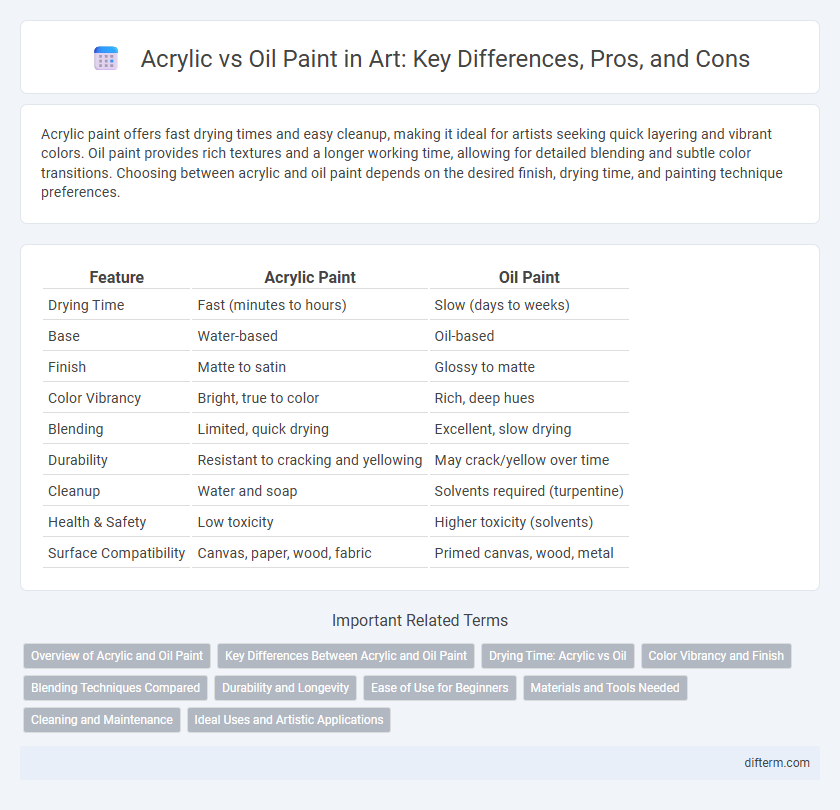Acrylic paint offers fast drying times and easy cleanup, making it ideal for artists seeking quick layering and vibrant colors. Oil paint provides rich textures and a longer working time, allowing for detailed blending and subtle color transitions. Choosing between acrylic and oil paint depends on the desired finish, drying time, and painting technique preferences.
Table of Comparison
| Feature | Acrylic Paint | Oil Paint |
|---|---|---|
| Drying Time | Fast (minutes to hours) | Slow (days to weeks) |
| Base | Water-based | Oil-based |
| Finish | Matte to satin | Glossy to matte |
| Color Vibrancy | Bright, true to color | Rich, deep hues |
| Blending | Limited, quick drying | Excellent, slow drying |
| Durability | Resistant to cracking and yellowing | May crack/yellow over time |
| Cleanup | Water and soap | Solvents required (turpentine) |
| Health & Safety | Low toxicity | Higher toxicity (solvents) |
| Surface Compatibility | Canvas, paper, wood, fabric | Primed canvas, wood, metal |
Overview of Acrylic and Oil Paint
Acrylic paint is a fast-drying medium made from pigment suspended in acrylic polymer emulsion, prized for its versatility and water solubility, allowing for easy layering and quick work. Oil paint consists of pigment bound in oil, usually linseed, offering rich texture, depth, and extended drying time that enables detailed blending and subtle gradations. Artists often choose acrylics for rapid execution and vibrant color retention, while oils provide greater flexibility in manipulation and durability over time.
Key Differences Between Acrylic and Oil Paint
Acrylic paint dries rapidly due to its water-based composition, enabling faster layering and quick project completion, while oil paint requires extended drying times, often days to weeks, allowing for richer blending and texture development. Acrylics offer vibrant, flexible finishes resistant to yellowing, whereas oil paints provide deep, luminous hues with a natural gloss that can darken over time. Durability varies as acrylics resist cracking and fading in various conditions, and oil paints maintain traditional archival qualities favored in fine art but demand careful preservation.
Drying Time: Acrylic vs Oil
Acrylic paint dries significantly faster than oil paint, typically within 15 to 30 minutes, enabling artists to work quickly and apply multiple layers in a single session. Oil paint can take anywhere from 24 hours to several days to dry, depending on thickness, pigment type, and environmental conditions, which allows for smooth blending and extended manipulation. This difference in drying time influences techniques, with acrylics favoring rapid layering and oils supporting detailed, gradual color transitions.
Color Vibrancy and Finish
Acrylic paint offers high color vibrancy with a glossy finish that remains consistent as it dries quickly, making it ideal for artists who prefer bold, bright colors and fast layering. Oil paint provides rich, deep hues with a natural, luminous finish that enhances texture and depth due to its slow drying time, allowing for intricate blending and subtle color transitions. The choice between acrylic and oil paint significantly affects the artwork's final appearance, influencing both vibrancy and surface finish.
Blending Techniques Compared
Acrylic paint dries quickly, allowing artists to layer colors rapidly but requiring swift blending to achieve smooth transitions. Oil paint's slow drying time enables more extended blending periods, facilitating subtle gradations and richer textures. Mastery of wet-on-wet techniques in oil results in seamless color mixing, while acrylics benefit from techniques like glazing and using retarders for enhanced blending effects.
Durability and Longevity
Acrylic paint offers superior durability due to its quick-drying, flexible synthetic polymer composition, which resists cracking and fading over time. Oil paint, known for its rich color depth, has exceptional longevity when properly maintained but is more prone to yellowing and cracking as it ages due to its slower drying oils. Conservation specialists often recommend acrylics for artworks exposed to variable environmental conditions, while oils remain favored for their traditional, long-lasting finish in controlled settings.
Ease of Use for Beginners
Acrylic paint is easier for beginners due to its fast drying time and simple water-based cleanup, allowing quick layering and corrections without waiting long periods. Oil paint requires more skill in handling longer drying times and the need for solvents like turpentine, which can complicate the painting process for novices. The versatility and forgiving nature of acrylics make them the preferred medium for those just starting out in painting.
Materials and Tools Needed
Acrylic paint requires synthetic brushes, palette knives, and water for thinning and cleaning, making it ideal for quick setups and easy cleanup. Oil paint demands natural bristle brushes, solvents such as turpentine or mineral spirits, and primed canvases to ensure proper adhesion and drying. Both mediums benefit from quality palettes, but oil painting often requires additional materials like linseed oil and varnishes for texture and preservation.
Cleaning and Maintenance
Acrylic paint cleans easily with water and mild soap while still wet, making maintenance straightforward and hassle-free. Oil paint requires solvents like turpentine or mineral spirits for cleaning brushes and surfaces, which can be harmful and necessitate proper ventilation. Over time, acrylic paintings resist yellowing and cracking, whereas oil paintings need periodic varnishing to protect against dirt and discoloration.
Ideal Uses and Artistic Applications
Acrylic paint dries quickly and is ideal for artists seeking fast layering and experimentation with mixed media, making it perfect for abstract and contemporary works. Oil paint offers rich textures and prolonged drying times, allowing for detailed blending and glazing, which suits classical, realism, and portrait painting techniques. Both mediums excel in different artistic applications, with acrylic favored for versatility and immediacy, while oil remains preferred for depth and luminosity.
acrylic vs oil paint Infographic

 difterm.com
difterm.com